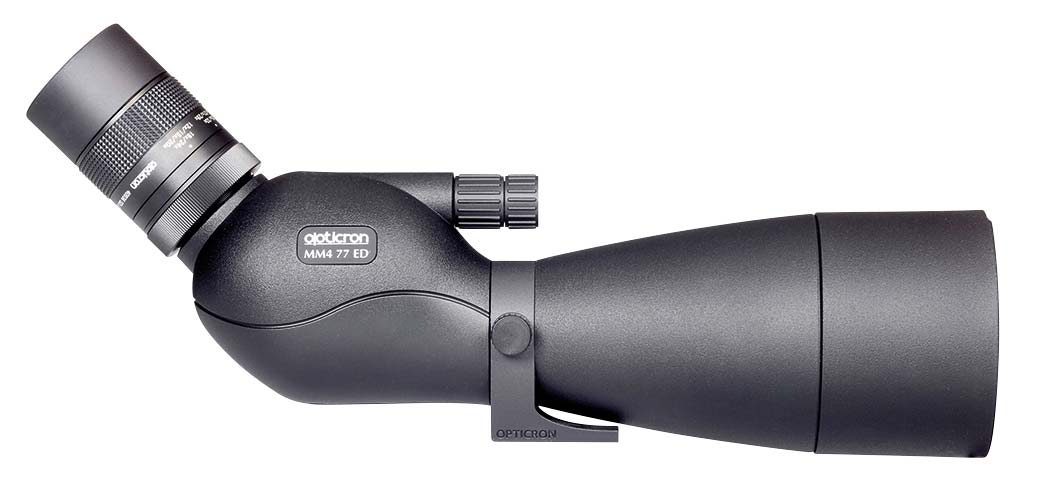Opticron MM4 77 ED/45 fieldscope
After 25 years of evolution and development of the 'MM' concept, Opticron has launched an addition to this well-established series of small scopes, designed to meet the growing demand for lightweight, space-saving high performance field equipment.
But this time it's different. Back in the days of yore, birders may recall the fledgling Mighty Midget range of diminutive spotting scopes, the forerunners of today's MM travelscope series. Building on the maxim 'smaller, lighter, brighter, sharper', Pete Gamby, Opticron's Sales and Marketing Manager, told me: "The MM4 77 was jointly developed by Opticron and one of its Japanese optics-manufacturing partners using the MM4 60 as a baseline, but with the brief to deliver something that would give the 'alpha' scopes a run for their money. It is the smallest and lightest 80-mm-class scope available. It weighs about 400 g less than the ES 80, but thanks to its superior optical system, delivers brighter and sharper images. It also has almost 30 per cent more aperture than 65 mm scopes, but is about the same size and weight."
The above may be true, but I have to ask myself does this addition to the MM series still constitute a 'travelscope' in the true sense of the word, or should it be in a league of its own? To my eyes, it is undoubtedly the latter.

The scope's body material combines aluminium alloy, polycarbonate and magnesium in order to reduce weight. It is fully protected by Nitrile Butadiene Rubber (NBR) body armour. This resilient, synthetic rubber is commonly used in the automotive and aeronautical industries and is generally resistant to oil, fuel, and other chemicals.
Other physical characteristics include an easily extendible objective lens hood and a tripod mounting foot. The latter can be rotated through 180 degrees around the narrow waist of the scope, click-stopping at five intermediate points, while a standard, finger-operated locking screw secures it in position.
There is a soft, flexible NBR objective lens cap, which remains on the hood when it is extended. One result of the cap's flexibility, however, is that it isn't secure, and retracting the hood loosened it or even pushed it off altogether. Use should therefore be limited to transport and storage as otherwise it could easily become detached and lost in the field.
Focusing is achieved using a dual-speed wheel mounted on the prism housing. This split, rubber-milled ring turns very smoothly and the extent of its use depends on the eyepiece coupled with the scope's body. I trialled two eyepieces: the highly popular, top-of-the-range SDL v2 18-54x zoom and the HDF T WW 20x fixed magnification eyepiece. Both produce different results. The latter has a wider field of view than the equivalent magnification on the zoom and the image is noticeably brighter, too. Furthermore, I found I was able to see the full field of view when the eyecup was completely extended. The eyecup does not click-stop in any fixed positions, instead it twists out smoothly to stay put at any extent required by the user.
Another functional aspect of using the HDF is the redundancy of the fine-tuning part of the dual-focus wheel. The relatively low magnification and the resultant increased depth of field simply removes the need for any fine-focusing adjustment.
This is not the case with the SDL, and the higher you go up the magnification scale, the more adjustment the focusing needs. I found it quite sensitive at the highest magnification and I was not able to see the full field of view when the twist-out eyecup was extended beyond the first of three optional settings above the base position.
Image clarity and brightness are good across the full range of magnification in the SDL, although diminishing a little when the magnification is ramped up, while remaining at a high level in the HDF. Both eyepieces deliver almost edge-to-edge sharpness. There is some minor curvature of field evident in both. Chromatic aberration is negligible in the centre of the image, only becoming noticeable in the outer 5-10 per cent of the field. There is a narrow yellowish ring around the perimeter of the image when using the HDF eyepiece.
The image appears 'cold' and neutral. The colour palette, tone and contrast are very pleasing, all combining effectively to furnish satisfying images of Northamptonshire's summering Western Cattle Egrets, allowing me to appreciate the subtle colour tones as I watched the adults feeding and resting out in the open, as well as deep in the shadows, close to a newly discovered nest site.
For its objective size, this telescope is appreciably light and compact. From a quality perspective, every unit is tested in Britain to check for spherical aberration, astigmatism, resolution and so on. The MM4 77 is unique to Opticron – no other brand has access to its design. Anyone thinking of spending up to £1,000 on a mid-range telescope and eyepiece set should certainly consider this as an option.
Further info
- Price: £649 (body only); £329 (SDL v2 18-54x zoom eyepiece); £139 (HDF T WW 20x eyepiece)
- Size: 320x107x95 mm (body only)
- Weight: 1,259 g (body only)270 g (SDL v2 zoom eyepiece); 151 g (HDF T WW 20x eyepiece)
- Field of view: 37-24 m at 1,000 m (SDL v2 zoom eyepiece); 58 m at 1,000 m (HDF T WW 20x eyepiece)
- Light transmission: n/a
- Close focus: 5.5 m
- Gas filled: yes
- Waterproof: yes
- Guarantee: 30 years (body); 10 years (eyepieces)
Verdict
- Image clarity and brightness are good
- Edge-to-edge sharpness
- Objective lens cap easily detached


